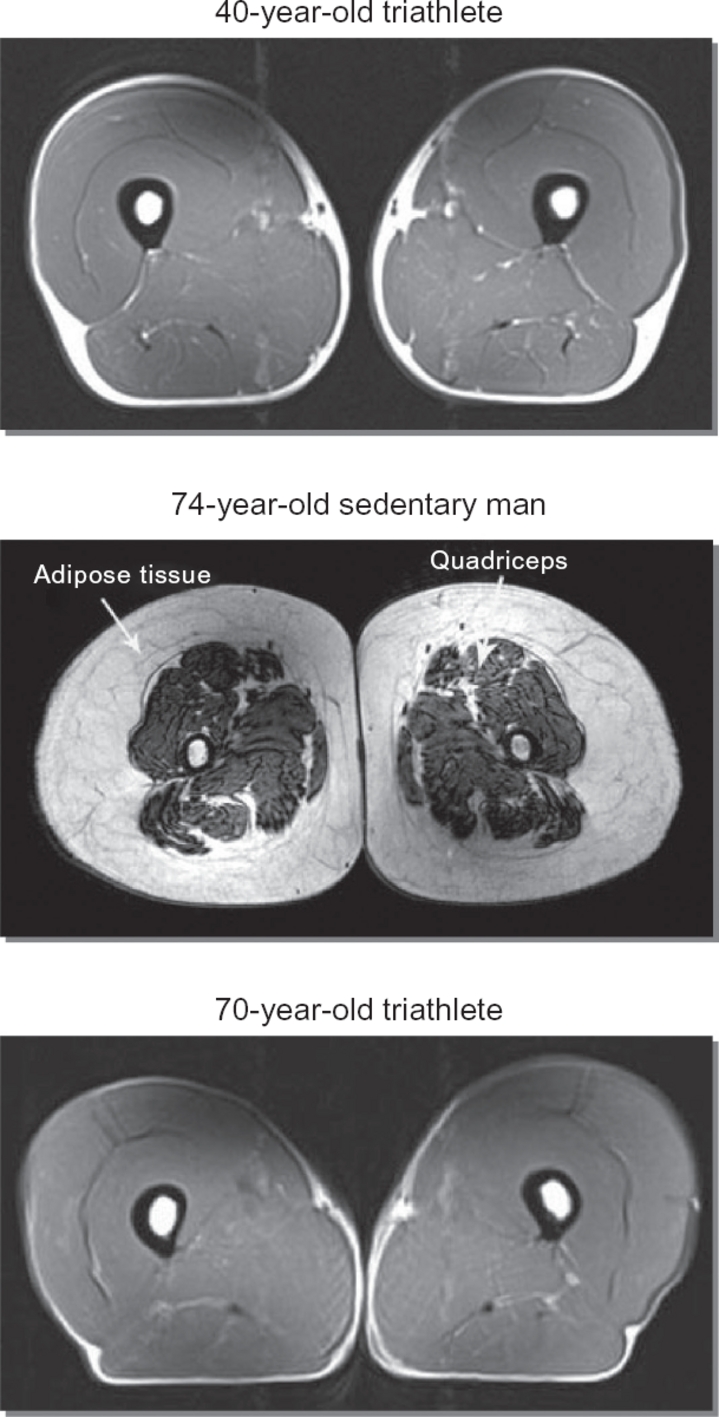Everyone loses muscle size and strength with aging, to increase risk for disability, accidents, diseases, loss of independence and premature death
Benefits of Exercising As You Age
A review of 16 major studies found that just thirty minutes a week of strength training is associated with up to a 20 percent reduced risk for dying from any cause, or from cancer, heart disease or diabetes
Aging causes you to lose strength, no matter how much you exercise. Muscles are made up of hundreds of thousands of individual fibers, like a rope is made up of many strands. Each muscle fiber is innervated by a single motor nerve. With aging you lose motor nerves, and with each loss of a nerve, you also lose the corresponding muscle fiber that it innervates. Thus, for example, the vastus medialis muscle in the front of your thigh contains about 800,000 muscle fibers when you are 20, but by age 60, it probably has only about 250,000 fibers. However, after a muscle fiber loses its primary nerve, other nerves covering other fibers can move over to stimulate that fiber in addition to stimulating their own primary muscle fibers. A regular exercise program can help to slow the loss of muscle fibers and improve mobility
Aging and Lack of Physical Activity are Major Risk Factors for Sarcopenia
• Sarcopenia causes increased risk of falls, broken bones, disability, loss of mental function,
and premature death
• People who had very weak handgrip strength had signs of accelerated aging, as measured by deterioration of the DNA in their cells
• Muscle weakness predicts increased risk for: physical disability in older people
 Inactivity Causes Rapid Loss of Muscle Size and Strength
Inactivity Causes Rapid Loss of Muscle Size and Strength
If you inactivate a leg by putting it in a cast, you lose a significant amount of muscle size in just four days
Muscles are made up primarily of two types of fibers: fast twitch fibers that primarily govern strength and speed, and slow twitch fibers that primarily govern endurance. Inactivity and aging both cause a far greater loss of the fast twitch muscle fibers that govern strength and speed
My Recommendations
We are all likely to have some enforced periods of inactivity, but if you realize how quickly you lose muscle strength and how much longer it takes to gain it back, you will avoid voluntary inactivity as much as possible. For example, when you plan a vacation, make sure it involves physical activity that is at least equal to your regular exercise program.
As you age, expect to become weaker and more likely to fall and break your bones. To enlarge muscles and slow the natural loss of strength with aging, you should lift weights a few times in a row or lighter weight many times in a row. You can become quite strong by using 10 to 15 strength-training machines (for different muscle groups) three times a week. Do two or three sets of 10 repetitions on each machine. Always stop immediately if you feel any pain, tearing or excessive burning. See Making Muscles Stronger.
Caution: Check with your doctor before starting a new exercise program or changing the intensity of your existing program. If you are not already doing strength-training exercise, first check with your doctor to make sure you do not have any condition that may be harmed by exercise. Then hire a personal trainer or join a gym and ask for instructions on how to use the weight-training machines. You gain strength and increase muscle size by exercising intensely enough to damage the Z-lines in muscle fibers and when the Z-lines heal, the muscle is stronger and larger. You get z-line damage whether you lift and lower a heavy weight a few times or lift and lower a much lighter weight many more times. End the workout immediately if you feel severe pain or if you have pain that does not go away as soon as you stop lifting the weight. See: Strength Training Guidelines
Retaining Strength with Aging
Weight Lifting for Middle-Age and Beyond
Other healthful lifestyle habits include:
• following an anti-inflammatory diet that includes lots of vegetables, nuts, beans, whole grains and other seeds, and restricts sugar- added foods, all sugared drinks, meat from mammals, processed meats and fried foods
• maintaining a healthful weight
• avoiding smoke and alcohol
• keeping blood levels of hydroxy vitamin D above 20 ng/mL

